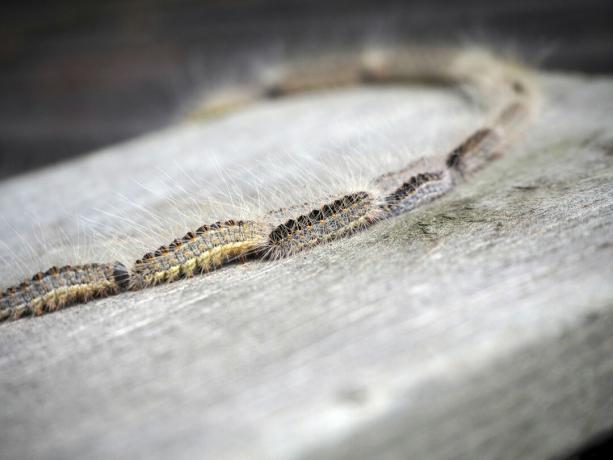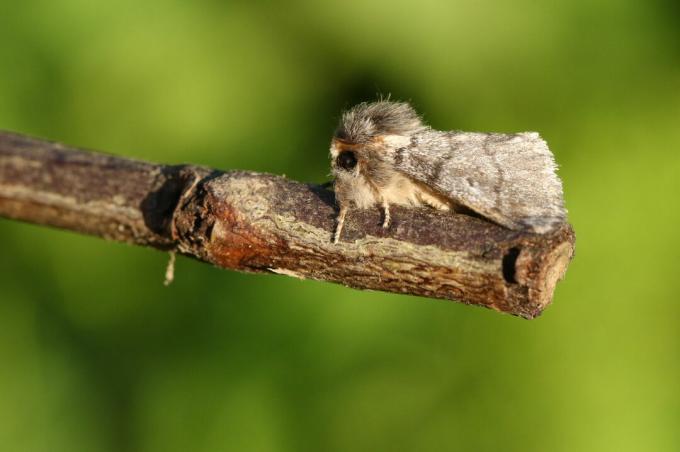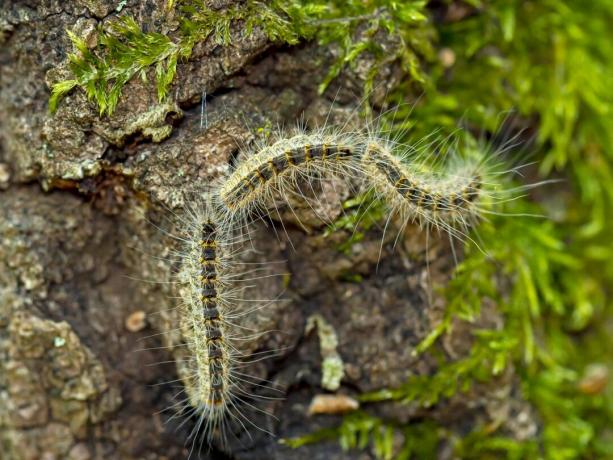The oak processionary moth damages oak trees and causes allergic reactions in humans. We show how to successfully combat and remove it.

It actually looks quite cute, like the fluffy brown caterpillars of the oak processionary moth (Thaumetopoea processionea L.) running in a long line in order to eat the leaves of our oak trees - you almost want to gently stroke the towering stinging hairs. Unfortunately, however, the soft-haired larva of the oak processionary moth is a serious one pest to be taken, which also harms humans and animals with its allergy-causing stinging hairs can. All on topic Rash caused by the oak processionary moth you'll find here.
Here you can find out how to identify caterpillars and moths of the oak processionary moth (abbreviated to "EPS") and how to prevent them. You will also find all information on the development, distribution and harmful effects of the spinner caterpillars. For the sake of your health, however, it is better to leave the fight to a specialist.
contents
- Distribution and diet of the oak processionary moth
- Recognize oak processionary moths
- Harmful effect of the oak processionary moth
- Development of the oak processionary moth
- Prevent oak processionary moths
- Combat oak processionary moths
- Is the oak processionary moth notifiable?
Distribution and diet of the oak processionary moth
The warmth-loving oak processionary moth has been on the rise in Germany since around 1990. Its development is favored by climate change. All types of oaks and, in exceptional cases, other deciduous trees, such as hornbeam, beech, birch or robinia, are attacked by it. The pest occurs preferentially in light, warm forests with a high proportion of oaks and on the sunny southern edges of these forests. Individual trees in parks are also welcome.
Federal states most affected by the oak processionary moth:
- Berlin
- Brandenburg
- Saxony-Anhalt
- Baden-Wuerttemberg
- North Rhine-Westphalia
- Bavaria

Recognize oak processionary moths
In order to recognize an infestation at an early stage, it is important to be able to identify the moth with certainty. The larvae of the oak processionary moth are nocturnal. On their back there is a wide and dark back line with velvety hairy fields. Long stinging hairs are formed from the third larval stage. From the fifth larval stage, the caterpillars lay large webs of caterpillar silk, which serve as protection and a nest for pupation. The behavior of the caterpillars is eponymous: the sociable animals often move in single file, one behind the other, as if they wanted to form a solemn procession.
The adult butterflies have a wingspan of about 3 to 3.6 centimeters and are hairy all over. However, their hair is not made up of stinging hairs, so it is harmless. While the wings of the males show two clearly visible transverse stripes, the stripes are weaker or not present at all. The moths are also nocturnal, so they are relatively rare.

Harmful effect of the oak processionary moth
As a rule, an infestation with the oak processionary moth is very easy for a healthy tree to cope with. Even after being completely bare, affected oaks will sprout well again in the following year. However, repeated infestations over several years are problematic. Basically, the weakening can be caused by various abiotic (e.g. drought, heat, lack of water, frost) and biotic (oak powdery mildew, oak jewel beetle, gypsy moth) factors lead to a relevant loss of vitality, so that in some forests plant protection with stomach poisons has to be used to prevent entire stocks from dying to preserve. Especially in public parks, the spinner poses a risk to our health, because the stinging hairs can trigger severe reactions in the skin and respiratory tract. Here you can read all about how to make a rash or other symptoms can avoid.
Development of the oak processionary moth
Following this paragraph is a tabular representation of the development of the oak processionary moth. The female moths lay their eggs, which are about one millimeter in size, between the end of July and the beginning of September in the upper crown area of oak trees. A clutch can consist of 100 to 200 eggs and is arranged in the form of an oblong plate and carefully camouflaged. At the beginning of the vegetation period, the first larval stage, which is still yellowish-brown in colour, hatches from the eggs. This feeds on the leaves of the oak and eats the entire leaf - only the middle rib is spurned by the caterpillars. Depending on the weather, the first larvae of the third stage of development can be present from April. From this stage they have the typical stinging hairs, which are equipped with barbs and a nettle poison. Pupation occurs in June or July. After three to six weeks as a pupa, the adult moth finally hatches to father the next generation.

Prevent oak processionary moths
A preventive plant protection treatment of oaks and other deciduous trees is not considered sensible by the Federal Environment Agency. In the case of particularly endangered trees, however, you should carry out repeated checks in order to be able to react in good time if an infestation occurs. Because chemical control measures, for example, can only be used in the first and second stages of development. Such treatment is no longer possible by mid-May at the latest. In general, the promotion of natural opponents leads to a certain reduction in the severity of the infestation. However, an effective decimation of the warmth-loving oak processionary moth is only possible through longer periods of cold weather.
When is there a high risk of infestation for oak processionary moths?
- Oaks stand in a monoculture or in an open landscape with little undergrowth of other plants
- There has been an infestation in previous years
- Nearby deciduous trees were affected in the previous year
- Mild winters and warm summers favor development

Combat oak processionary moths
Combating the oak processionary moth is difficult for various reasons. On the one hand, the butterfly prefers to attack trees that are already tall and these can hardly be treated with conventional spraying equipment. Second, approaching a group of oak processionary moths is a very bad idea. Therefore, never try to remove the animal yourself! If you are forced to be near an infested tree, please note the following.
Tips for staying near an infested tree:
- All skin areas must be protected as well as possible by clothing
- Do not touch caterpillars and webs
- wash clothes after contact at 60 °C; Thoroughly shower hair and body

When problems arise in your private garden due to the presence of oak processionary moths, you really only have two Possibilities: Either you avoid the infested area in order to avoid contact with the stinging hairs - this is done by the Federal Environment Agency recommended. Or you can arrange for the caterpillars to be controlled by a specialist company that specializes in pest control. The oak processionary moth can be combated very well with biological means - Bacillus thuringiensis – preparations like ours Plantura Zünslerfrei XenTari®are also used by specialist companies. For you as a private user, however, the remedy has not yet been approved for the oak processionary moth. Suction and scraping are also common methods that are used. Burning or felling the infested plants carries the risk that the stinging hairs will spread even further, which means that these methods are ruled out.
Is the oak processionary moth notifiable?
At this point we would like to point out that there is no obligation to report the oak processionary moth. However, you can and should voluntarily report an infestation in private and public areas to the responsible public order office or green space office. There you may receive further tips and, if necessary, measures to remove it will be initiated.
More hints as you Avoid oak processionary moth rash can be found in our special article.



